Kingston upon Hull
Kingston upon Hull, or just Hull as it is usually called, is a city in Yorkshire on the northern bank of the Humber Estuary.

Understand
Early history
A settlement called Myton, although not listed in the Domesday book of 1086, existed at the confluence of the River Hull and Humber in the 11th century. In the late 12th century the monks of the nearby Meaux Abbey created the new town of Wyke, from the Scandinavian meaning creek (i.e. the River Hull). The town of Wyke later became Hull. The names Myton and Wyke remain as political ward areas of the city.
With the River Hull offering a harbour for the import and export of goods, and the Humber estuary being connected to other major rivers, the town of Wyke upon Hull became established and thrived. This situation drew the attention of the town to King Edward I who visited, and eventually granted Kyngeston (or King's Town) upon Hull its Royal Charter on April 1, 1299. The lay of the main roads to and from the city are the result Edward's involvement. The interest of various Kings including Henry VIII have had a bearing on what the visitor, with a little understanding, may see when visiting the city. Hull's importance as a port, and in its early years as an arsenal, at one time second only to London's arsenal, caused walls with battlements and towers to be initiated in 1327, blockhouses on the east bank of the River Hull in 1542 and a citadel, again on the east bank, in 1681. Although all these have long gone, their imprint on the old town along with the subsequent docks, can still be appreciated.
Modern history
In some ways the 20th century was the most consistently calamitous era in the long, long history of this great maritime city. From a peak in prosperity at the start of the 1900s, with industrial and mercantile might that placed it on a level with almost any other city in the land, by the last decade of the century its litany of hard luck stories had cruelly conspired to turn Hull into a nationally perceived shadow of its former self. The last hundred years were, however, a sad chapter in an epic story, and at the birth of a new century, the place Larkin called the 'lonely northern daughter' has begun to miraculously revive and stake its claim for prosperity and respect once more.
Much investment is being directed into the city, encouraged by the huge success of The Deep as a centre-piece major visitor attraction, a sprucing up of the Old Town, and new retail offers. To the visitor, the face of Hull has almost been altered beyond recognition with the redevelopment of Ferensway, and the construction of the landmark St Stephen's centre, Hull's premier shopping experience. This comprises a shopping mall with upmarket chains, a modern hotel, the newly opened Hull Truck Theatre building, and a music learning centre for young people. The visitor experience has been much improved with the redevelopment of Hull Paragon Interchange with a new bus station and refurbished railway station. New developments planned include a new footbridge over the River Hull.
Anybody who has experienced the city first-hand without any preconceived notions or bias, will tell you that Hull is unique. It is no longer isolated, as transport links with the rest of the country are more than adequate. This was not the case for hundreds of years though, and the result is a true one-off. The place has a genuine cultural identity and character of its own. It is reflected in the accent (pronounce "oh no" as "er ner" and you will have an idea), the humour, the self-effacement and spirit of its people. Hull's colourful (at times startling) but always fascinating urban fabric and history are its markers.
The flat landscape and low but often breathtaking historic buildings, give a sense of there being a massive backdrop of sky, and when combined with a view out to the brooding, bleak, mighty expanse of the Humber Estuary from the point at which it converges with the River Hull, it becomes apparent that there is something special in the location of the town.
Along with the poetry of its setting, Hull has a formidable connection with some of the most influential poets in English literature. Amongst others, Andrew Marvell was baptized in Holy Trinity Church and attended the Old Grammar School. Coventry-born poet and University of Hull Librarian Philip Larkin lived at 32 Pearson Park for most of his life, and Stevie Smith was born in Hull. In the second half of 2010, Hull is celebrating Larkin's life and verse with the Larkin25 events including poetry readings, a Larkin tourist trail and a 'Plague of Toads' sculpture trail recalling Larkin's poem, 'Toads'. A statue of Larkin will later be unveiled at Paragon Interchange.
The city has branded itself as the "Pioneering City", and this claim is backed up by a list of many firsts originating on Humberside. The technology for Liquid Crystal Display (LCD), for example, was discovered and refined at the University of Hull in the late 1960s. The city is also a UK leader in the development of broadband and telecoms technology.
In 2007 Kingston-Upon-Hull celebrated another of its numerous remarkable achievements when it commemorated the life of its greatest son William Wilberforce and celebrated his starring role in the abolition of the British slave trade which in turn changed the face of world history. There was a wide range of events across the city.
Hull was nominated as UK City of Culture 2017.
Tourist information
- 🌍 Hull tourist information centre, Hull City Council, 1 Paragon St, ☎ +44 1482 223559, e-mail: tourist.information@hullcc.gov.uk. M-Sa 10AM-5PM, Su 11AM-3PM.
Get in
By plane
It's the far side of the country, yet Manchester Airport (MAN IATA) is often the most convenient, as it has global connections and competitive fares. There's an hourly rail service from the airport changing at Leeds for Hull, taking 2 hr 30 min.
By contrast, Humberside Airport (HUY IATA) is only 20 miles from Hull via the Humber Bridge, but there's only a couple of flights per day to Aberdeen and Amsterdam plus holiday charters to the Med. Stagecoach bus X1 runs hourly between Hull and the airport, taking 30 min.
Doncaster Sheffield (Robin Hood) Airport DSA IATA is 60 miles west via M180. There are short-haul flights by Flybe, eg to Amsterdam, Belfast City, Berlin Tegel, Dublin & Paris CDG; flights by Wizz to to Poland, Lithuania and Romania, and Med holiday destinations by the major package operators. First South Yorkshire Bus X4 runs between the airport and Doncaster Frenchgate Interchange, the railway and bus station, taking 25 min. Buses run to the airport every 30 min M-Sa from 5:30AM to 11:30PM, hourly on Sundays, with the last bus back to town at midnight.
Leeds Bradford Airport (LBA IATA) has better European connections than Robin Hood, but lacks a rail or motorway link. Take the airport bus into Leeds for direct bus or train to Hull.
By train
- 🌍 Hull Paragon Interchange, the railway and bus station, is in the city centre. There's a taxi rank just outside, and car rental desks on the concourse.
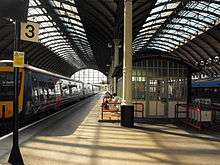
Direct Hull Trains run every couple of hours between Hull and London Kings Cross via Doncaster. But it's usually more convenient to change at Doncaster, trains every 30 min, journey 3 hours.
An hourly direct train runs to Manchester Piccadilly: change there or in Leeds for Manchester Airport (2 hr 30 min).
An hourly fast train runs to Sheffield (80 min) via Doncaster and Meadowhall shopping centre. In between there's a slow train, but you're as quick waiting for the next fast service. Change at Sheffield for services to Birmingham, Bristol and Cardiff.
An hourly train runs to York - change there for services to Durham, Newcastle and Edinburgh.
There's a train every couple of hours from Hull to Scarborough (80 min), via Beverley, Bridlington and Filey.
By car
The city is at the eastern end of the M62 (which changes to the A63 shortly before Hull), and can be easily accessed from the rest of the UK motorway network. It has good access from Lincolnshire and the south via the A15 and the Humber Bridge, and can be accessed by the A1079 from York and the North.
By bus
There is a park and ride service available from the outskirts of the city (Priory Park.)
Priory Park and Ride lies south of Hessle Road off Priory Way. Follow the signs on A15 and A63 (Clive Sullivan Way) if you are coming into Hull. The postcode is HU4 7DY. The bus number is 700. Buses run approximately every 10 to 15 minutes from 7AM onwards, (7:30AM on Saturdays.) The last service back from the city centre is M-F at 6:44PM or Sa at 5:59PM. There are no services on Sunday. The service drops off at the Kingston Communications Stadium (and is therefore useful for match-days as parking capacity near the stadium is very limited), Hull Royal Infirmary (return fare: £1.90 per adult; £1 per child) and Hull City centre (return fare £2.40 per adult; £1.25 per child.) Season tickets are available at £8.50/week, £34.20/month (HRI) or £11.00/week, £43.00/month (City Centre) (January 2013)
National Express coach services operate in and out of Hull Paragon Interchange (see below 'Get around by bus'). Several of the services operate through to King George Dock to connect with ferry services through to the continent.
Stagecoach Hull X62 has buses several times a day between Leeds City Bus Station and Hull interchange.
By boat
Hull is a major port and ferry terminus for P&O Ferries sailings to and from Rotterdam in Holland and Zeebrugge in Belgium. Other routes are present within the UK. Buses run to and from the ferry terminal but when going from the city to the terminal get to the bus at least fifteen minutes early as departure times are not always on 'the dot'.
Get around
By bus
The bus station in Hull city centre along with the adjacent Paragon railway station, forms the Hull Paragon Interchange. The main entrances/exits for the station are located on Ferensway, within a short distance of the new St Stephens covered shopping street to the north, and the central core of the city to the east. Black cabs use the front (Ferensway side) of the Interchange. Private cars dropping off and collecting passengers can enter from Anlably Road. There is no parking charge for this but there are only a few spaces and waiting time is limited. There is a large 'pay and stay' car park here.
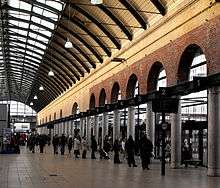
Bus services in Hull are operated by East Yorkshire Motor Services and Stagecoach. As with most local transport services in the UK outside of London, ticketing and fares on bus services are not integrated across operators, and you have to pay separately for each bus you ride on. Tickets are purchased from the driver when you board the bus. All information regarding bus routes, times, etc., can be gained from the passenger information boards, the Travel Centre within the station and can also be downloaded from the city council's website. The buses come and go from a concourse on the north side of the Interchange where there are some small shops from which snacks can be bought. There are a few seats at each bus stop but more at the west end of the concourse. The metal seats are cold in winter! If travelling by local bus to the Interchange to catch a train leave enough time. While buses are quite frequent the timetables at the bus stops around the city may not be accurate because a traffic hold ups along the route.
By car
The centre of Hull is compact and while there are car parks there is little point of trying to actually get round the city centre by car as distances are short, and on-road parking can be problematical. Some businesses may have some designated parking for clients or visitors. Moving around by car outside the city centre is easier.
By bicycle
Hull is one of the best cities for cycling in the UK, with extensive cycle paths, including some off road routes. National Routes 65 and 66 also converge here.
By foot
The city centre is fairly compact and mainly pedestrianised, which creates a relatively hassle-free walk around town. However, care should be taken when crossing from the southern side of the Old Town towards the marina area, as the route is intersected by Castle Street - a wide and very busy dual carriageway.
Disabled access
Hull has two schemes to help disabled people get about the city to shop and to do business. Both the organisations have reciprocal agreements so membership covers both of them. It's an excellent way for disabled people to get about the city without having to bring their own equipment into town.
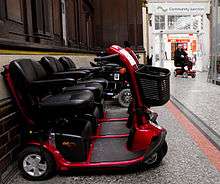
TravelExtra (supported by Yorkshire Forward), Community Junction, Paragon Station, Tel: +44 1482 212832, hire electric scooters, wheelchairs and wheeled walkers. A year’s membership is £5 but a membership form has to be filled in for this. The first use of an electric scooter, wheel chair or wheeled walker is free after which there is a small daily charge. For electric scooters this is £2 which are available between 10AM and 4PM.
Shopmobility, Level 2, Princes Quay Shopping Centre, Tel: +44 1482 225686 also hire scooters and have a reciprocal agreement with TravelExtra.
See
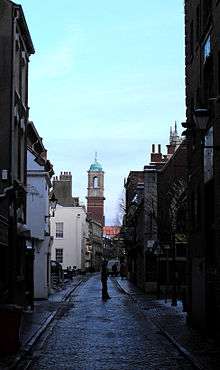
Although Hull was amongst the most heavily bombed British cities during the Second World War, the 700 years since the granting of its first charter have left it with a fascinating wealth of architectural gems. From Flemish inspired façades to beautiful domed civic buildings. From dock offices to imposing industrial heritage warehouses and mills. From the medieval cobbled charm of the old town, grand private merchant's houses and Georgian terraces to cutting edge modern design.
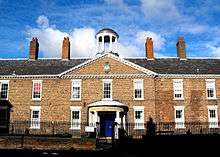
- 🌍 The Charterhouse, ☎ +44 1482 329307 (Master), +44 1482 320026 (Matron). The Charterhouse is open to then public once a year, during Hull's Heritage Weekend, and each Sunday there is a service in the Chapel from 10AM to 11AM which the public can attend. Tucked away in a rather inauspicious area of the city, The Charter House is on Charterhouse Lane, and lies within a small conservation area. The wealthy merchant and first mayor of Hull Sir William de la Pole founded a Priory of Carthusian monks here in 1350, with the further intention of establishing a hospital. The ‘Gods House Hospital’ was eventually established by his son, the charter being granted in 1384 when the first master was appointed. It housed 13 poor men and 13 poor women, and was surrounded by fields through which the River Hull flowed. The institution prospered from income derived from its lands. This attracted the attention of Henry VIII who, in 1536, closed the Priory and turned the monks out. The hospital, however, remained and over time acquired the name The Charterhouse. This name is a corruption of Chartreuse in France where the order of Monks originated from. With Hull’s refusal to admit Charles I in 1642 and the start of the English Civil War, the town became a target for the Royalists and the Charterhouse, being outside the town walls, was demolished so a gun battery could be placed there to defend the town. In 1649 the Master, with his flock, returned to the site and the Charterhouse was rebuilt. However, neglect and decay caused this building to be pulled down in 1777 and a third one was built, the only remaining piece of the original priory being the stone over the door of the Master's House. But more was to come and although the Charterhouse survived World War II, the blitz that Hull suffered caused much damage to its buildings. Since its restoration and expansion with improved living quarters the people living there now no longer represent de la Poles ‘indigent and decayed persons’ but pay for their accommodation and are called Residents. What is known as the Charter House consists of the Master's House and walled garden where Andrew Marvell is said to have played under the Mulberry tree and on the northern side of the road Old House which contains the fine Chapel with its Adams ceiling.
Queen Victoria Square
The centre of Hull, from which all of the wide shopping streets of the late 19th/early 20th century radiate. At its heart stands Queen Victoria, surrounded by the magnificent domes of The Maritime Museum and The City Hall.
- 🌍 Ferens Art Gallery. Free entry. Permanent collection of Sculpture and Paintings from medieval to present day, as well as a regular programme of temporary exhibitions from around the world. Strong on old European Masters, particularly Dutch and Flemish, the Ferens also houses some of the best contemporary art in the country. Includes masterpieces by Frans Hals, Antonio Canaletto, Stanley Spencer, David Hockney, Helen Chadwick and Gillian Wearing. There is a pleasant cafe on the ground floor of the gallery with an outside section overlooking part of Prince's dock. In February to April each year it hosts the 'Open Exhibition' to which, for a modest fee, amateurs as well as professional artists can submit their own work for sale or just display.
- 🌍 Maritime Museum. Free entry. Formerly the Whaling Museum and housed in the original Dock Offices for the Prince's Dock and Queen's Dock (now Queen's Gardens). It is a huge, quaintly old-fashioned museum dedicated to Hull's glorious conquest of the High Seas and to the often tragic sacrifices made to it. An elegant staircase rises from the entrance hall and there are displays to interest all ages from the skeleton of a whale to models of ships to explanations of fishing methods.
- 🌍 Hull City Hall. Completed in 1903 and designed by Frank Matcham, the City Hall to some extent defied total destruction by Luftwaffe. When the bomb damage of 1941 was finally made good in 1950 it reopened to emerge, with its green copper roof, as one of the most loved structures in the city. Around the upper west end of the building is a frieze commemorating famous musical composers. The cupola of the previous town hall, built in 1866 by Cuthbert Brodrick, is sited at the west side of Pearson Park. The City Hall now regularly hosts rock, pop and classical concerts as well as comedy events. Left of the entrance is the booking office for events in the city and to the right The Tourist Information Office.
Queen's Gardens

- 🌍 Queen's Gardens. Opened in 1930 and built on top of the old Queen's Dock. The dock was built in the late 1700s, and at 10 acres it was the largest dock in England. However, it was not until 1854 that it was named Queen's Dock after Queen Victoria. You can still make out the original shape of the dock in the walls and buildings surrounding the gardens. Some of the buildings on the south side are the old warehouses of the dock. At the east end stands the Wilberforce Monument and at the west, the old dock offices now the Maritime Museum. The gardens are sunk and contain flowerbeds, seating and a large grassy area.
- 🌍 The Guildhall, ☎ +44 1482 613902 (Guildhall Curator). Runs adjacent to and on the south side of Queen's Gardens and with Alfred Gelder Street on its south side. Built between 1903-1916, to a design chosen by competition, it is the home of the City Council, it also houses the city's silver and the Hull Tapestry, as well as the old magistrate's court and below this the cells! The Guildhall is a great slab of early 20th century civic pride, prosperity and confidence. At the west end sits a sculpture symbolising 'Maritime Prowess' atop its ornate Neo-Classical design and at the east end a clock tower. Starting in 1991 The Hull Tapestry took 15 years to complete and in 19 panels depicts important aspects of the city's history and development. The tapestry can be viewed (free of charge) Monday-Thursday 08:30-16:30, and Friday 08:30-15:30. To view it ask at the reception desk of the Guildhall. Guildhall tours are also available free of charge but these must be booked in advance.
- 🌍 Mick Ronson Memorial Stage. The main focus of scheduled events throughout the summer months. Constructed after the untimely death from cancer of Mick Ronson, the guitarist who along with two other Hullensians formed David Bowie's band the Spiders from Mars in the early 1970s, and later went on to success with Bob Dylan, Elton John, Lou Reed and Morrissey among others. The stage hosted a memorable speech by freeman of the city Archbishop Desmond Tutu in 1997. Behind the stage is a plaque to commemorate the fictional character of Robinson Crusoe, who set sail from Hull in the famed novel of the same name by Daniel Defoe. This book - it has been argued - was the first novel in the English language in 1719.
Trinity Quarter
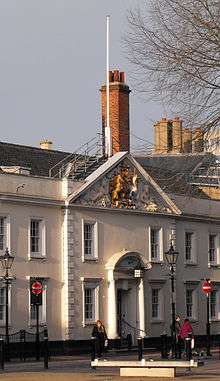
Created around the site of the old market square in front of Holy Trinity Church, and taking in the grand Victorian Hepworths Arcade, this is the main home in the city centre for vintage clothes, independent record shops, and alternative retail outlets. The square has benefited in recent times from sensitive restoration including seating and public art, as well as a great selection of small cafés with outdoor areas to make it a vital destination for any sightseeing tour.
- 🌍 Trinity House. A large cream building - occupies the area on the corner of Trinity House Lane and Postern Gate. In the 14th century a Carmelite Friary stood here. Trinity House took over the site in the 16th century. Starting as a guild to care for mariners and their families, Trinity House expanded to control the movement of shipping in the Humber. The present façade dates from 1753, and of particular note is the decorated pediment on the east side incorporating a lion, unicorn, Britannia and Neptune.
- 🌍 Holy Trinity Church. It is the largest parish church in England, but as a piece of imposing medieval ecclesiastical architecture, it is more like a cathedral. The oldest parts date back to c. 1300 and the 150-ft-high tower contains a ring of 15 bells.
- 🌍 Andrew Marvell statue (stands on a plinth in Trinity Square). (1621-1678), poet and MP for Hull. Born at Winestead-in-Holderness just outside Hull he moved to the town when his father took up the position of Lecturer at Holy Trinity church. He was brought up at the Charter House where his father was Master and the garden in which he played is still there. Behind his statue is the Old Grammar School which he attended.
- 🌍 Old Grammar School (Hands on History Museum), S Church Side, ☎ +44 1482 613902. This is one of the oldest grammar schools in England dating back to the 16th century and open until 1873. From 1884 to 1915 it was the Choir School for Holy Trinity church. Among its many famous past scholars were Andrew Marvell and William Wilberforce. In 1988 it became Hands on History Museum which focuses on the history of Hull and it's people, recreates Victorian Childhood in the classroom and contains a genuine Egyptian Mummy. Child friendly. Free Entry.
- 🌍 The Woollen Warehouse. With its cartouche above the door of a lamb being weighed, it stands to the east side of the Old Grammar School. This building was once the home of Hull’s Wool Exchange and stands testimony to Hull’s early importance in this trade. The export of wool was initiated in the Middle Ages by the Monks in the area and the various deserted medieval villages of the Wolds (the rolling chalk lands to the north of Hull) are thought to be the result of the early wool trade expansion.
- 🌍 Prince Street. The arch leading to Prince Street is on the west side of the square. This curving Georgian street leads to Dagger Lane. The Prince after which it was named was the future King George IV.
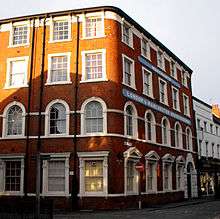
- 🌍 Merchants Warehouse. is on the corner of King Street and Robson Row which lies on the south west corner of the square. Once the offices of various merchants it is now flats. This large brick building is a reminder that Hull has no natural building stone nearby so many of the early buildings were of brick.
The Museum Quarter and High Street
This area runs alongside the River Hull, and was the main street at the centre of the medieval old town.
- 🌍 Arctic Corsair. Hull's last remaining sidewinder trawler, berthed in the River Hull to the rear of the Museum Quarter complex. Guided tours are available. Free Entry.
- 🌍 Streetlife Museum of Transport, High St, ☎ +44 1482 300300, e-mail: museums@hullcc.gov.uk. M-Sa 10AM-5PM. Showcases 200 years of transportation history. Free.
- 🌍 Wilberforce House, 23-25 High St, ☎ +44 1482 300300, e-mail: museums@hullcc.gov.uk. M-Sa 10AM-5PM, Su 1:30PM=4:30PM. Birthplace and residence of William Wilberforce (1759-1833), MP for Hull and slavery abolitionist, whose anti-slavery bill was finally passed in 1807 after his tireless campaigning. The house has been a museum in his memory since 1903. Free.
Princes Quay and Whitefriargate
Whitefriargate is the thoroughfare that links the old and new towns, and has traditionally been the main shopping high street for centuries. After decline caused by the emergence of new shopping centres, a new future is planned for the street, with the hope of it attracting cafes, bars and galleries.
- 🌍 Princes Quay. A shopping centre built on stilts over the quay. Home to a large Vue Cinema - which was at the time of opening - the first fully digital cinema in Europe. The futuristic glass shards of the centre have dated surprisingly well, and the walk up the long, light and airy entrance from Queen Victoria square and over the water is as exhilarating an experience you could ask for from a city centre shopping trip.
- 🌍 Beverley Gate, 35 Whitefriargate. At the Queen Victoria Square end of Whitefriargate an excavated hole containing a small amphitheater and brick wall signals the medieval Beverley Gate. This belonged to the original city walls, and is where King Charles I was refused entry to Hull in the 17th century - the first military act of the English Civil War.
- 🌍 The Land of Green Ginger. A narrow street connecting the junction of Whitefriargate and Silver Street with the southern end of Manor Street. The name has been used in many works of fiction, but its origin is unclear. It was thought to have originated due to the existence of a nearby medieval spice market, but is more likely due to the son of a Dutch trading family by the name of 'Lindegroen' who possibly established his business in the area and is therefore most probably an English corruption of 'Lindegroen Jonger' (Lindegroen Junior.) The smallest window in England is located at the George Hotel on The Land of Green Ginger.
- 🌍 Parliament Street. leads off Whitefriargate about halfway down. This is the home of many professional practices in the city centre, and this is reflected in its fine Georgian architecture. It was built to give access to the town dock now Queens Gardens.
The Marina and around
- 🌍 Hull Marina. Developed from the old derelict Humber Dock in the early 1980s, provides space for 270 yachts and small sailing craft in its permanent and visiting berths. The area is an enjoyable stroll with some great cafes and old pubs, and annually hosts the Sea Fever Shanty Festival.
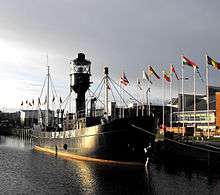
- 🌍 Spurn Lightship (In one of the permanent berths). Built in 1927, it served for 48 years as a navigation aid in the approaches of the Humber Estuary. Free.
- As the city centre's prime business district the area to the west known as Humber Quays is earmarked for huge office and residential development, with the Hull and Humber World Trade Centre, the HQ2 building and Freedom Quay apartments along with high quality landscaping to the river frontage having been completed as phase 1.
- 🌍 The Deep. A huge and spectacular aquarium looking out over the Humber estuary. Built as Hull's main millennium project, it has surpassed all expectations to become a massively successful tourist destination and second only in terms of visitor numbers to the Eden Project in Cornwall.
Out of the city centre
- 🌍 Humber Bridge (Barton-upon-Humber). Spanning the Humber Estuary it was the longest single span suspension bridge in the world when it was completed in 1981.
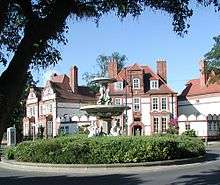
- 🌍 The Avenues. A conservation area whose varied house architecture and street plan will be of interest to the casual visitor and to those interested in Victorian, Edwardian and post-World War I middle class residential housing. Starting from 1875, when Prince’s Avenue was opened and soon after the inception of Pearson Park, four parallel avenues, Marlborough, Westbourne, Park and Victoria and two cross streets, Richmond and Salisbury, were laid out between Chanterlands Avenue to the west and Prince’s Avenue to the east. The original farm land was subdivided for building purposes in such a way that it produced runs of properties of differing styles though generally towards the west houses are of a later date than those at the east. Circles with fountains were a feature and over the last few decades these have been restored –though not as full fountains. Originally houses had cast iron railings but these were removed for the ‘war effort’ but were never used, the metal being of the wrong kind! Their insertion holes can still be seen in places as can the odd piece of original railing though these are not along the frontage but between houses. By 1910 The Avenues was essentially in its current form. There are many interesting houses in the area but among the largest are those designed by George Gilbert Scott junior built between 1877 and 1879. These can be found along the west side of Salisbury Street between Westbourne and Park Avenue. One or two newer houses might be seen which have either been built on World War II bomb damage, old market gardens, playing fields or in one case a bakery. From its inception the fortunes of The Avenues has varied though over the recent decades the activity of the Avenues and Pearson Park Residents Association (APPR) has led, if not to reinstatement, to much preservation. On the first two Sundays in July many gardens are open to visitors and at Christmas many windows are lit as ‘Advent Calendars’. The Avenues is mentioned in Pevsner and Neave’s 1995 book but various booklets have also been published about the area. The most recent, ‘The Avenues Conservation Area –Practical guidance for residents on renovation, planning and design’ 2007 ISBN No 0-9541031-3-0, will be of interest to those with a curiosity for domestic architecture. By foot The Avenues can be accessed by those buses which pass along Prince’s and Chanterlands Avenues. These are available from the Hull Paragon Interchange. No buses pass through the area. During the day on road parking may be available but at night spaces are usually scarce.
- Hull Parks. Three of the four main ones were laid out in the late 1800s as a response to Victorian altruism to provide the population with open green areas for recreation. There are four major parks but several smaller ones. Like many parks in the world, wandering in them at night may not be judicious.
- 🌍 East Park, e-mail: eastpark@hullcc.gov.uk. During 1885 and 1886 unemployment and hunger gripped some parts of Hull and some work was provided for the unemployed in laying out part of East Park. A large park, of some 120 acres and recently improved, it is in east Hull off Holderness Road about 2 miles east of the city centre and accessible by the majority of buses that go east. It boasts a large boating and fishing lake, a pavilion and café, a paddling pool, bowling greens, football and rugby pitches, a walk through aviary, a fenced deer park and a smaller lake for sailing models boats. On most Sundays enthusiasts can be found sailing a variety of model boats, of varying complexity, from surface craft to the occasional submarine. A splash boat operates in the summer months along with pedal boats that can be hired. There are a number of shops and pubs located near the various entrances which provide the park with good amenities.
- 🌍 West Park. Much smaller than East Park it was opened in 1885 and is adjacent to the Walton Street Park and Ride. A model railway is operated by volunteers and more information on this could be obtained from Hull and District Society of Model and Experimental Engineers. There are bowling greens and at the south west corner is the interesting Carnegie Library now a local heritage resource centre. The park is now rather over shadowed by the KC Stadium and suffers a little from the proximity of busy roads. However, there is a £7 million make over planned for this park
- 🌍 Pickering Park. Named after Christopher Pickering a successful trawler owner who donated 50 acres of land for a park which opened in 1911. Adjacent to the park Pickering also built Pickering Homes, a set of 12 attractive alms houses for ex-fishermen. Situated in west Hull on Pickering Road off Boothferry Road. The park has fishing ponds, football pitches, bowling greens, ornamental gardens, an aviary and a boating lake. The park hosts concerts and fishing competitions
- 🌍 Pearson Park (the park lies between Beverley Road and Prince's Avenue about 1 mile north west of the city centre). This is Hull's first public park, tree planting starting in 1860. It was opened as the Peoples Park, but was later named Pearson Park after Zachariah Pearson, ship owner and at one time Mayor of Hull. He gave the land to the people of Hull but being a shrewd business man retained 12 acres of land round it for housing development. Pearson went bankrupt running arms to the southern states in the American Civil War and is buried in a modest grave in the nearby old General Cemetery on Spring Bank West, which itself is worth a visit. At the east side there is a large pair of ornamental metal gates and within the park there is a small lake and fountain, a ‘Victorian’ glasshouse, statues of Queen Victoria (1861) and Prince Albert (1868), an elegant Victorian drinking fountain (1864), the cupola of the old Town Hall (west side) and next to this a children’s playground. Bowling greens are situated at the east side. Many of the large houses surrounding the park are of interest and include the one in which Philip Larkin, the poet, lived from 1956-1974.
- 🌍 The Garden Village. During the late 1800s and early 1900s a number of industrial philanthropists around the country became aware of the very poor housing occupied by many of their workers and decided to build houses of a higher standard for them. One such philanthropist was Sir James Reckitt, a Quaker, who developed the Hull based company Reckitt and Sons which was started by his father Isaac. The company later became Reckitt and Colman and more recently Reckitt Benckiser. In 1907 Sir James formed a company, the Garden Village (Hull) Ltd., with his own money and initiated the building of The Garden Village which he opened on July 1st 1908. The houses were rented, the amount depending on their size, but some 50 years ago tenants were allowed to buy them. Garden Village has a mix of house size and architectural styles (but all have gardens), there is a large grassy area, The Oval, where the houses were individually designed, a Club House supporting various activities, a colonnaded shopping centre restored as flats and three alms houses, now homes for the elderly, referred to as Havens. All the roads are tree lined and named after trees e.g. Chestnut Avenue, Lilac Avenue. The area, which lies some 2 miles NE of the city centre (near East Park), can be approached from Holderness Road via Village Road or Laburnum Avenue or from James Reckitt Avenue via Laburnum or Chestnut Avenues.
Do
- 🌍 The Hull History Centre. A must for people trying to trace their ancestors from the area and Hulls history in general. Opened in 2009 this state-of-the-art facility it holds documents from the City Council's Family History and City Archives as well as some from the University of Hull. It is behind the New Theatre on Worship Street.
- Humber Speedboat. ride from Victoria Pier £3.50.
- Stand at the statue of Henry Wilson and look in all four directions at the fantastic buildings around you.
- 🌍 Hull Truck Theatre, Ferensway, ☎ +44 1482 323638. To see a production from one of the most successful local theatre companies in the country.
- RED Gallery, 19 Osborne St. Since RED opened in 1997 it has provided Hull with an independent exhibition space and 'laboratory' for contemporary art. The gallery's viewing audience has been growing steadily with around 200 visitors attending each exhibition. In between the formal exhibitions the gallery offers the opportunity to local art students to organize and publicize their own shows. RED is a non-profit making initiative, run collectively by a small group of local artists.
- Watch football at 🌍 The KCOM Stadium (KC Stadium), Walton Street HU3 6HU. The home team, Hull City AFC, play in the Championship, the second tier of English football. The stadium, capacity 25,000, is shared with Hull FC Rugby League Club. Commonly referred to as 'The Circle' after the cricket ground it replaced, the stadium is half a mile west of city centre off A1105 Anlaby Road.
Walking
Hull lends itself well to walking, and the following highlights five walking routes around the old part of the city.
- The Docks Walk. This walk, which is just about wheel chair friendly, takes you along the docks which encircled the old town.
- The early town was substantially walled from the River Hull at a point just south of where North Bridge now stands to the River Hull where it meets the Humber. The wall, pierced by four land gates for entry and exit, formed three sides of a ‘square’ round the old town. Until King Henry VIIIs intervention the River Hull formed the town’s major defence on east side. The pattern of roads in the old town is influenced by the wall and its gates. The Beverley Gate in what was the west wall is of some historical significance as it was here that King Charles I, who was interested in acquiring Hull’s arsenal, was barred from the town by Sir John Hotham on a rainy 23 April 1642. This action was a contributory factor in the start of the English Civil War. The development of the first docks essentially followed the line of the demolished old town wall and walking along these docks you are encompassing the old town.
- Standing by the tall Wilberforce Monument at the east end of Queens Gardens (formally Queen’s Dock) you are at a point where a lock joined the River Hull to the first of Hulls docks. The lock ran under what is now Hull College, the large white building at the east end of the gardens. Opened in 1778 the dock was first known as Town Dock then the Old Dock and eventually Queen’s Dock renamed to commemorate the visit of Queen Victoria to the city in 1854. When it was built it was the largest dock in England and took much pressure off the harbour in the River Hull. The north side of the dock is slightly higher than the south as the soil dug out when excavating the dock was tipped here. At the west end of Queen’s Gardens stand the domed Dock Offices. The offices were built in 1867-71 and built in such a way as to look east along Queen's Dock and south along the other docks which allowed dock officials to see the coming and going of ships. The offices are a Victorian statement to the importance of the port of Hull.
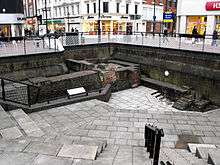
- Walking along the centre of Queen’s Gardens towards the Dock Offices you are approximately following the line of the towns old North Walls. Looking south from the Dock Offices (now the Maritime Museum) you see Prince’s Dock. This was originally called Junction Dock, because it joined two docks, but was renamed Prince’s Dock after Prince Albert the husband of Queen Victoria. This dock opened in 1829 (decommissioned in 1968) and joined the southern most dock, Humber Dock (opened 1809, now the Marina), to Queen’s Dock. Monument Bridge (so called because the Wilberforce Monument once stood near it) crossed the lock joining Queens Dock and Prince’s Dock and some of its stanchions can be seen in the nearby excavation. The bridge (removed in 1932) opened between 30 to 40 minutes each hour for the passage of ships which was a considerable inconvenience to road users! Importantly, in the same excavated area as the bridge stanchions are the remains of the famous Beverley Gate. It was at this gate that King Charles I was refused entry into Hull, the first overt act of defiance of the English Civil War. Walking towards Prince's Dock Street, on the east side of Prince’s Dock, you pass the end of Whitefriargate. This is not the original name of this street but never the less an ancient one being named after the white robed Carmelite friars who arrived in Hull in the 13th century. At the east end of this street are the interestingly named streets of ‘Land of Green Ginger’ and ‘Bowlalley Lane’ as well as the famous old, though slightly hidden, Ye Olde White Harte pub. It is said that it was here the meeting took place in 1642 to exclude King Charles I from Hull. The buildings on the east side of Prince’s Dock are mainly old warehouses and associated shipping offices but notable frontages are Roland House and the entrance to Hull Trinity House School. Railway lines use to run along the dock side and rows of open sheds allowed the loading and unloading of ships. Princes Quay shopping centre was built partly over the dock in 1991.

- South of Prince’s Dock is the Marina (Humber Dock, opened 1809). It lies on the south side of the very busy Castle Street, part of the south orbital road which leads to, besides other things, the eastern Hull docks. The old Spurn Light Ship is moored here, entry is free. In September the Marina serves as a backdrop for Hull's famous international ‘Shanty Festival’. The Railway Dock (opened 1846) which comes off the west side of the Marina now also houses pleasure craft. Towards the southern end of the Marina, on the east side, is Humber Street. Originally this was called The Ropery as ships ropes where made here and this was the southern most street of the walled town. Soil from the excavation of the docks was used to reclaim the land south of here. Humber Street was, for many years, the centre for fruit, vegetable and flower importation into Hull. Redevelopment of this area is planned. At the end of the Marina is the lock leading to the dock Basin and the Humber. West of the Basin is a new office development built on what were the railway goods yards which were next to the Railway Dock. Close to the Basin on the east side is the Minerva pub and near to this some excellent award winning public toilets. East of this area, across the River Hull, can be seen the Deep, Hull’s famous marine attraction.
- A recommended walk from here is up Queens Street, across the busy Castle Street, along Market Place turning right down Scale Lane and then left (north) up High Street. Diversions to Holy Trinity church, with some of the earliest examples of medieval brickwork in the country, and into the old town can be made and are highly recommended.
- The Haven Walk takes you round the north part of the Haven, Hull's early harbour. Many early wooden sailing ships were built along this section of the River Hull, some of them 'Men o'War' for the English navy. As Hull developed the Haven became so crowded with ships that Queens dock had to be built. The walk is under a mile long and is just about wheelchair friendly. Some dereliction will be seen but one hopes that if, or when, development takes place the important features will be saved. At North Bridge it is possible to extend this walk to take in The Charterhouse. Details of this are found in section "See".
- For a stranger the easiest place to start is at the east end of the Guildhall (built 1916). Facing east towards Drypool Bridge cross the road (care!) and walk past the City Hotel pub and the black and white 'half timbered' White Hart pub (1904) to the junction of Salthouse Lane and High Street. Both these pubs were listed grade II in 1994. Turning north up High Street a few new houses are past on the west side.
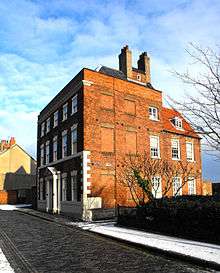
- On the east side can be seen Blaydes House (circa 1760) with its Georgian portico. It is now the location of the Hull Maritime Studies Centre of the University of Hull. A period hall leads to an elegant stairway lit by an equally elegant arched rear window. In the 16 and 1700s the Blaydes were important merchants and shipbuilders who had dealings with Samuel Pepys for Admiralty work though in 1702 got into trouble when they blocked North Bridge with a ship’s ‘boltspright’ (bowsprit)! Blades staith (a Norse word meaning ‘landing place’) runs down the south side of the house and their land ran from this staith north to their dry dock behind the Dock Office further up the street.
- Just a little further on the east side of the street is Haworth House (built 1887) and named after the owners but latter used in the interwar period as ‘National Works’ offices. The Haworth and Blaydes family were related by marriage. Beyond this house on the east side are two small houses, Barton House and its neighbour. The only notable feature on the west side is the small road called North Walls, the rest of the area having been redeveloped. This road follows the line on the original North Walls of the city and during the construction of the new buildings their foundations came to light. North Walls lead to Queens Gardens.
- The next building on the east side is the elegant Dock Offices built in 1820. A side door on the right side of the building allowed merchants, workers etc access, the front door not being available to them! With the increase in shipping these offices moved, in 1871, to those at Queens Gardens. Behind and to the right of the Dock Offices building is the dry dock that belonged to the Blaydes and where the 400-ton Bethia (Bounty) was built in 1782. The large dry dock to the north of the Dock Offices was originally the basin to the Queens Dock lock, the Queens Dock being the other side of the Hull College, the large building to the west. The lock basin was turned into a dry dock in 1957 and was in operation into the 1990s. A plaque in the pavement and bricked lines in the road show the position of the old entrance to Queens dock. The lock gates are no longer water tight and the dock fills and empties with the tide. The dock has an example of a Scotch Derrick crane. Here High Street becomes Dock Office Row. Towards the end of Dock Office Row a house (number 3) has an ornate Georgian entrance.
- At this junction of four roads the small dead end road on the right is the remains of Bridge Street which led to the old North Bridge. The large building on the left of this small road is North Bridge House, originally a warehouse or mill but now flats. Grade II listed in 1994.
- Here the walk can be extended to the Charterhouse. This is only a couple of hundred metres further on and is found off Wincolmlee directly opposite the top of High Street across George Street. Turn left down Charterhouse Lane by the old Board School. For details of the Charterhouse consult "See" above. To continue this walk -- at the main road (George Street) turn east towards and over North Bridge. Like Drypool Bridge it is a bascule bridge. Follow the road curving left but stop on the corner. Across the road is a pharmacy, once Annisons Funeral Directors and Livery Stables. The horses were stabled upstairs and a walk through the arch to the yard beyond reveals the staircase on the left which the horses used. Diagonally across the road can be seen the ornate terracotta brick parapet of the first ferro-concrete bridge built in Britain in 1902. A plaque on the south west end commemorates this.
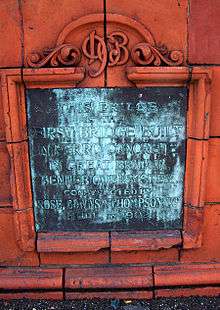
- Follow the road round the corner for a few meters to the small dead end road on the right and walk to the east river bank. This piece of road is what is left of the eastern one to the old North Bridge. From here can be seen some timber work on the west bank which relates to the old North Bridge. Next to the bridge is the tall North Bridge House with elements of the hoisting floor, interesting hip-roof, iron finials on the ridges and attractive chimney stacks.
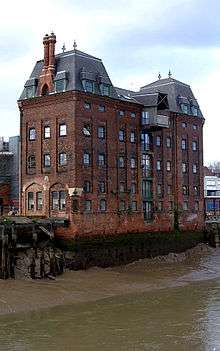
- Walking along the east river bank towards Drypool Bridge (in 1888 a wrought iron swing bridge) the gates of four old locks can be seen in the west bank as well as the backs of the high street houses. The elegant rear window of the Blaydes house can be seen. In the distance can be seen the smallish conical tower of the City Archives, the square clock tower of the Guild Hall, the crenelated tower of St Mary’s church and the metallic grey dome of the Law Courts. The path passes over the entrance to an old dry dock to the left. The dock is now silted up but interestingly the end is bow shaped and not straight. The past shipping activity along here is indicated by mooring stanchions. Towards Drypool Bridge two large buildings are evident. One is the land mark Shotwell tower where pellets are made for shot gun cartridges and on the far side of the bridge is the Ranks Clarence Flour Mills. Following his fathers death (his father being a miller) Joseph Rank started milling in Hull in 1875, his first windmill still stands on Holderness Road. Clarence Flour Mills on the side of the River Hull was rebuilt in 1952 having been destroyed by bombing in World War II. Joseph’s son, J. Arthur Rank, became the ‘movie mogul’.
- At the end of the path mount the steps or ramp to Drypool Bridge. Down stream you can see the Arctic Corsair, a side winder trawler (free entry but booking necessary), the Tidal Surge Barrier (built 1980) and beyond that The Deep (opened 2002), Hulls famous ‘submarium’. The Deep is built on the site of another famous shipyard, that of the 19th century ship builder, Martin Samuelson. On Drypool Bridge turn right which brings you back to the Guildhall. Alternatively cross the road –carefully—(there is a crossing near the Guildhall) and proceed on another walk along the west bank of the River Hull. This starts next to the south side of the bridge lifting gear.
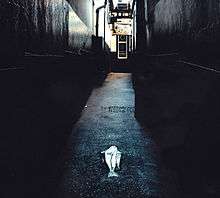
- The Fish Trail. The trail takes you round old Hull by following various fish types embossed on the pavement. People take rubbings of the best ones but make sure children are safe from peoples feet! To get the most out of this walk get a leaflet (£0.40) from the Tourist Information Office (Tel +44 1482 223559) which is to the right of the City Hall entrance. On completion of the walk the Tourist Office will give you a free certificate to say you have done it!
- Walking with Wilberforce Trail. This trail takes you round the old town among places that would probably have been familiar to William Wilberforce who was famous for his part in the abolition of the transatlantic slave trade. He was born in Hull and his early education took place here. He later became the Member of Parliament Hull. The trail starts where he was born at Wilberforce House in High Street. If you have time you could start with visiting the house, now a museum about slavery. There are twelve stops in the trail the final one being the Wilberforce Monument at the east end of Queens Gardens. Obtain a leaflet from the Tourist Information Office (Tel +44 1482 223559)on the right hand side of the City Hall entrance.
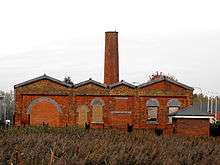
- The Victoria Dock Heritage Trail takes you around a south east area of Hull which at one time included Victoria Dock (1850-1970) and The Timber Ponds 1 and 2. Only a few landmarks remain as most disappeared under the Victoria Housing development. The area was once a vibrant cog in Hull’s economy but little remains to testify to this. The walk of about 2 hours takes covers an area from The Deep, on the edge of the River Hull, to the eastern edge of where Timber Ponds and Earle’s Ship Yard used to be. A leaflet can be obtained from the Tourist Information Office.
Events
- Sea Fever Shanty Festival. The major part of Hull's Maritime Festival. Usually held on the first Saturday and Sunday in September it attracts major shanty singers from the UK as well as from around the world. The main stage is along the Prince's dock side and groups sing in the pubs near by. While some stalls along the dock sell variety a of things others represent various organisations. All performances are free though the concerts in the City Hall on Saturday evening and the Survivors Concert on Sunday evening are by ticket. Various barges are moored alongside and can be visited free of charge. If your into shanty singing it's a really good weekend.
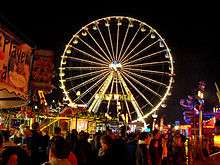
- 🌍 Hull Fair. A huge travelling fair, and one of the city's greatest regular occasions, if not its greatest. It is the biggest European fair, and at over 700 years old, also one of the oldest. Visiting the fair is a must, though for evening visitors from a long way out of town, overnight accommodation may be necessary. The first charter for a ‘fair’ was granted in 1278 though in 1293 Edward I proscribed the original length of it. In the 18th and 19th centuries, it developed more into a fair, and less of a festive market, and later mechanisation allowed more varied and bigger ‘rides’ to be developed. In 1888, the fair moved to its current site in Walton Street where itk occupies an area of 16 acres. Attractions vary: simple stalls where you can win prizes; large complex rides many of which may challenge one if not all your senses; children’s rides; stalls selling all manner of food (candy floss, hot- dogs, chips, brandy snap, toffee apples, coconuts, etc.) and goods (balloons, masks, toys, fancy hats, cheap jewellery, etc.) It is not easy to cover the whole fair in one visit and local people may go several times. Prices are less on the first afternoon the fair opens but daylight takes something away from the experience. At night the fair is brightly lit and its glow can be seen from miles away. At night it is crowded though generally safe but the hand of young children should be held as, in any crowded space, they can soon get lost from view in the mass of people. The weather can be cold so warm clothing is advisable. Police and medical services patrol the fair. Parking near the fair is difficult so a walk is usually required. Three main entrances are available; Spring Bank West and Walton Street, Anlaby Road and Walton Street and the metal bridge at the junction of Argyle Street and Londesborough Street. Hull Fair is held during the second week of October. The exact dates are available on the Hull Fair web site.
Learn
- The University of Hull is considered one of the friendliest universities in the UK. The foundation stone of the University College Hull (operating through the University of London) was laid in 1928 by King George VI. It obtained its own University Charter in 1954 as the University of Hull. The old campus was expanded by the addition of the old University of Humberside site which moved to Lincoln as the University of Lincoln. The University is on Cottingham Road, the front buildings of which are not without merit.
- The University of Lincoln also has a presence within the city though its main activity is now in the City of Lincoln.
Buy
Along with the recent influx of investment into the regeneration of the city centre, there is evidently a concerted effort to expand and improve upon the city's retail offerings. The St Stephen's shopping centre includes over 30 large format stores such as Next, USC, Cult, Zara and H&M along with many other high street names.
- 🌍 Princes Quay. Built on stilts above the Princes Dock the shopping centre is currently the largest mall in the city centre, with over one hundred shops on three floors.
- Planning permission has recently been granted to expand the main shopping centre of Princes Quay out to the west. The £300 million Quay West scheme would be an open air expansion, with the proposed regeneration of this land more than doubling the current size of the centre.
- For classic tailoring and trendy designer names, the cobbled Saville Street to the north of Queen Victoria Square is the best bet, with Read's and Bolo (Lyle and Scott Vintage, Puma Heritage, Diesel etc.) amongst them.
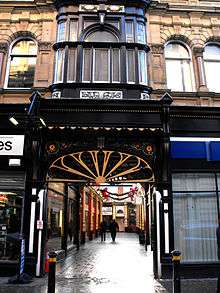
- Hepworth's Arcade. Unusual for having a right angle bend in it, is home to a quirky selection of stores including Dinsdales the brilliant old-school joke shop, Beasley's American work wear and vintage, Fanthorpes stereo shop, a fine art gallery called Myton Gallery which sells a variety of original paintings including those of Roger Davies; David Curtis (RSMA); Bruce Mulcahy (RSMA); Peter Bell and Sue Howells. There is also a Japanese and Oriental clothes and accessories boutique called Kimono My House. Take the weight off your feet at The Coffee Cup café. There is a rather unassuming entrance to the covered market at the bend of the arcade.
- The Covered Market (Trinity Market). The entrances to this are at the bend in Hepworth's Arcade, on Lowgate opposite Liberty Lane, North Church Lane via a pub and on Trinity House Lane. The main section of the market sells food stuffs, e.g. meat, fish, bread, vegetables. while the rest of the covered area has stalls selling a mixture of goods, e.g. records (specializing in Punk, Indie, New Wave, Psychedelia and Funk), cards, musical instruments, prints. The southeast corner of the market hall has a square tower which can be seen in the photograph of Posterngate above (see Architecture section).
- The south and west market exits lead out to the main square which contains a row of cafes and eateries facing out onto the beautiful, historic square.
- Tessies - Newland Avenue. An Aladdin's cave of vintage inspired fashion.
- Walton Street Market occurs on Wednesday mornings down Walton Street on the site used by Hull Fair. There is good parking. The Walton Street Park and Ride service leaves from here (bus number 701). Good weather brings out more stalls. For sale --- vegetables, meat, clothes, carpets, toys, electrical goods, plants, flowers, tools, fishing equipment, jewellery—you name it its probably there. The central area is given over to ‘car booters’ with a plethora of merchandise. Very crowded just before Christmas. Try to bargain?
Eat
- Boars Nest, Rudstone Walk near South Cave, Brough, ☎ +44 1482 445577, e-mail: boarsnest@boarsnest.karoo.co.uk. Sumptuously decorated Edwardian style restaurant.
- Larkin's Bar, 48-52 Newland Ave, ☎ +44 1482 440991. 11-11. Larkin's Bar is named after the poet Philip Larkin, boasting a great menu and one of the largest selection of craft beers in Hull.
- Lounge, Princes Ave. Great value food and buzzing atmosphere. Fantastic place to go on a Sunday afternoon or a light lunch with friends.
- Maharajah Restaurant, 245 Holderness Rd, ☎ +44 1482 224647. Hull's most popular and loved 'proper' curry house, established in 1990 and located 1.8 miles east of Hull City Centre. Very well priced and exciting menu, ultra-friendly service and welcoming, relaxed atmosphere. The Restaurant is regarded as one of the best in Northern England and has won numerous awards. A true people's establishment.
- May Sum, 1-7 Jameson St, ☎ +44 1482 606760. Cheap all-you-can-eat Chinese buffet, serving the famous zheng-qui.
- Raj Pavilion, Beverley Road.. Indian cuisine. Modern/extravagant decor and usually friendly staff. Eat in or take away. Can be expensive and food is fairly average. Chef/kitchen staff regularly change which is the downside to this place. Very close to city centre, so often very busy, particularly late on a night when the bars and clubs close.
- Thai House Restaurant, 51 Princes Ave, ☎ +44 1482 473473. Excellent atmosphere and great service.
- The Wilson, Freedom Quay, Wellington St, ☎ +44 1482 216306. 10AM-10PM. A cafe bar by day and a stylish restaurant by night, The Wilson has caused a stir in culinary and cultural circles since opening its doors in the autumn of 2010.
- Union Mashup, 22 Princes Ave, ☎ +44 1482 447788, e-mail: info@unionmashup.com.
- Zillis, 2 Posterngate, ☎ +44 1482 229988, e-mail: info@zillishull.co.uk. Fabulous restaurant and bar close to Holy Trinity Church, selling excellent Mexican, American, and European food for reasonable prices. It has a brilliant menu and good specials, with huge variety
- The Zoo Cafe, 80B Newland Ave, ☎ +44 1482 494352. Specializing in vegetarian fare. Very good and uncomplicated atmosphere.
Drink
Hull is certainly not short of traditional pubs.
The Avenues (Princes and Newland Avenue) on the outskirts of the city centre, is a traditionally Bohemian area which has taken off in recent years, with masses of new restaurants, bars and cafes. A great urban mix of artists, professionals, students, fashionistas and winos rub shoulders here every night of the week.
- Ye Olde White Harte. One of many delightful historic pubs in the old town. The upstairs 'plotting parlor' is believed to be where Sir John Hotham and various city elders met in 1642 and decided to deny King Charles I access to the city. When the King returned a few months later with an army, his defeat was the first military action of the English Civil War.
- The Adelphi, 89 De Grey St, ☎ +44 1482 348216, e-mail: paul@theadelphiclub.karoo.co.uk. One of the last surviving underground music venues in the country. Played host to many bands before they were household names including Oasis, Radiohead, The Stone Roses, Manic Street Preachers, The Bluetones and the Levellers.
- Cannon Junction, 366 Beverley Rd, ☎ +44 1482 474747. A cafe pub situated partly under the arches of the railway bridge on Beverely Road and consists of a couple of railway carriages and patio. An interesting place for a drink or meal.
- Old English Gentleman, Mason St, ☎ +44 1482 324659. A pub built in 1805 during Hull’s expansive Georgian period which has kept its old Victorian interior. It is behind the New Theatre at the corner of Mason Street and Worship Street. Because it is closeness to the theatre it’s popular with its patrons. A well kept old fashioned pub with a collection of photographs signed by well known thespians. Serves tea and coffee as well as food. Well worth a visit.
- Hollywood and Vine, 386 Beverley Rd, ☎ +44 1482 444300. A new rock club open until late, virtually next door to Cannon Junction. Housed in the old Mayfair cinema.
- Nellys Bar, 48 High St, ☎ +44 1482 225212. Former Irish pub, now selling cask ales and real ciders from micro-breweries around the country. Draught Belgian and German beers are also available.
- The Queens, ☎ +44 1482 470241. A pub on the junction of Queens Rd and Prince's Avenue. Frequented by a cross section of drinkers but popular with students. Screens Sky matches though the room adjacent to the main bar allows you, to some extent, to escape from these when they are on. Has a pool room. A place to sit, talk and drink.
- Sailmakers Arms, 159 High St, ☎ +44 1482 227437. A classically eccentric English pub, complete with beer garden that has to be seen to be believed!
- Walters Bar, 21 Scale Ln, ☎ +44 1482 224004. Over 21's upmarket city-centre bar specialising in Cask Ales, continental draught beers and fine wines.
- Ye Olde Black Boy, 150 High St, ☎ +44 7894 254043. One of several ancient High Street boozers with many spooky tales to tell. Claims to be Hull's oldest pub.
- The Zachariah Pearson, ☎ +44 1482 474181. A JD Weatherspoon chain pub next to the Old Picture House and takes its name from the once shipping magnet and Mayor of Hull who laid out the nearby park. A largish newish pub serving meals.
- Wokkas Bistro, ☎ +44 1482 329626. 9AM-10PM. Quick well-priced Chinese food to eat in or take away.
Nightclubs
Certain weeknights are student-only at some clubs, so you should probably check before going.
There are a number of different areas where clubs and pubs are located in groups. In the city centre there are, as referred to by locals, Old Town, New Town and George Street. The Old Town is on Lowgate which runs through to Posterngate where The Sugarmill is located. George Street is located north of Lowgate, here you will find Pozition along with Biarritz, Venue and many more. Visit George Street for the 18-30s style of bar. The New Town area is located around Carr Lane, It is based for the younger market 18-24 but has some good venues with good drinks offers and if your night has not quite ended and the other bars are closed it is worth a look, a few bars here have a 24-hour licence.
- Chi Chi, 1 Witham, ☎ +44 1482 323166. Home for Grapevine, one of Hull’s indie/rock and soul nights on a Tuesday, and the new home of YoYo – Hull’s original indie party night every Saturday.
- Code. Large club on Park St, behind St Stephens shopping centre specializing in Indie and Alternative nights.
- Fuel, 6 Baker St (city centre), ☎ +44 1482 228436. Metrosexual nightclub with an attitude free atmosphere. M: karaoke; Tu: rock; Wed: drag cabaret; Th: Pink Pounder; F & Sa: funky house & electro/pop, chart & commercial.
- Jack Rabbit Slims/Poly Esthers, 22-23 Witham., ☎ +44 1482 588450.
- The Piper, Newland Ave, ☎ +44 1482 498931. A long established club.
- Spiders, 9 Cleveland St, ☎ +44 1482 326698. Hull's premier student and goth nightclub, is east of the River Hull in and is completely without pretension. Unbelievably cheap drinks. Don't forget to try a Pan-Galactic Gargle Blaster.
- Sugarmill, 20 Prince's Dock St (corner of Posterngate and Princes Dock Street), ☎ +44 1482 227222.
- Welly Club, 105-107 Beverely Rd, ☎ +44 1482 221113. Just out from the town centre. Dance, drum and bass, indie.
Sleep
Budget
- Campanile Hotel, Corner of Beverley Road and Freetown Way, ☎ +44 1482 325530. 47 rooms. Prices vary depending on time of year. Breakfast extra. French restaurant on-site. £40-46 per room.
- Gables Hotel, 53 Park Ave, ☎ +44 1482 343426. No meals available. However, there are plenty of eating and drinking places near by on Prince's Avenue. £20 single, £38 double.
- Ibis Hotel. A modern hotel situated at the end Ferensway - the main road through the city centre. It's right next to the A63 (Castle Street) - the main road into town from the Motorway Network - and a three minute walk from the railway station. It's close to the main shopping area of the centre and a five minute walk from the popular restaurants and pubs on the marina. Room rates are about £46 per room per night.
- Old English Gentleman, ☎ +44 1482 324659. Five rooms. No breakfast but breakfast available nearby. Built in 1805 during Hull’s expansive Georgian period and situated in a conservation area it lies behind the New Theatre at the corner of Mason Street and Worship Street so its city centre being only a short walk to Queens Gardens and the Old Town. Single, double or triples at £22.50 per person
- Old Grey Mare Hotel, Cottingham Rd, ☎ +44 1482 448193. Directly opposite the entrance to the University of Hull. 12 rooms from £35-39. Breakfast extra. Evening meals in the pub bar.
Mid-range
- Holiday Inn, Hull Marina.
- Mercure Hull Royal Hotel, city centre next to The Hull Paragon Interchange, ☎ +44 1482 325087. AA 3 Star. 155 rooms which vary from £52.50 to £75 room only, with cheaper weekend deals available. Free Wi-Fi and parking. From £52.50.
- Willerby Manor Hotel, Willerby, 4 miles out of Hull, ☎ +44 1482 652616. A high 2 star hotel with 51 rooms and Health Club facilities. No single rooms only twins and doubles from £65 to £120 bed and breakfast depending on time and occupancy.
Splurge
- Cave Castle & Country Club, Church Hill, South Cave, Brough, East Yorkshire, ☎ +44 1430 422245. Four star hotel set in 150 acres of meadow and parkland some 7 miles west of Hull, just off the M62. 18 hole golf course and health club. Weddings and conferences. Room prices from £78-145.
- Tickton Grange Hotel & Restaurant, Tickton, Beverley, East Yorkshire, ☎ +44 1964 543666. A Georgian country house in 4 acres of gardens on the edge of the Yorkshire Wolds, 3 miles west of Beverley and 10 miles from Hull. 20 rooms. Weddings and Conferences. Three function rooms of different sizes.
- Village Hotel, Henry Boot Way, Priory Park, ☎ +44 844 847 2975 (premium rate number). Four star hotel in the city. One of the 22 Village Hotel chain. 116 rooms from £65. Pool and health/fitness club.
Stay safe
Efforts have been made to crack down on violent crime in the city centre, and some of the most troublesome establishments have been closed down to make way for new development. However, as with any other town in the UK, evenings on a weekend are a time when you should be particularly vigilant.
Some areas in the north of the city, predominantly Bransholme and Orchard Park are very impoverished and suffer from gang and drug related problems. These areas are best avoided, especially at night. Care should also be taken when travelling down Hessle Road and Preston Road but generally, tourists would have little reason to visit these areas anyway.
- Humberside Police, Humberside Police Headquarters, Priory Police Station, Priory Rd., ☎ +44 845 60 60 222 (non-emergency premium rate number).
Go next
- Beverley just north of Hull, is a green, pleasant market-town with a cathedral-sized Minster and attractive racecourse.
- Head north for three of England's true gems - the city of York, the Yorkshire Moors and the Yorkshire Dales.
- Lincoln, south of the river, is a fine old city.
- Book a two-night mini-cruise with P&O Ferries and go to Amsterdam, Rotterdam or Bruges.
| Routes through Kingston upon Hull |
| END ← | UK |
→ Rotterdam |
| END ← | UK |
→ Zeebrugge |
| merges with |
N |
→ Grimsby/Scunthorpe (via Humber Bridge toll) |
| Liverpool←Manchester←Leeds ← merges with |
W |
→ END |
| York ← Beverley ← | NW |
→ END |